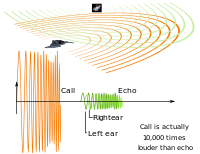
Photo from wikipedia
STUDY OBJECTIVES Tongue fat is associated with obstructive sleep apnea (OSA). Magnetic resonance imaging (MRI) is the standard for quantifying tongue fat. Ultrasound echo intensity has been shown to correlate… Click to show full abstract
STUDY OBJECTIVES Tongue fat is associated with obstructive sleep apnea (OSA). Magnetic resonance imaging (MRI) is the standard for quantifying tongue fat. Ultrasound echo intensity has been shown to correlate to fat content in skeletal muscles but has yet to be studied in the tongue. The objective of this study is to evaluate the relationship between ultrasound echo intensity and tongue fat. METHODS Ultrasound coronal cross-sections of ex-vivo cow tongues were recorded at baseline and following three 1 milliliter serial injections of fat into the tongue. In humans, adults with and without OSA had submental ultrasound coronal cross-sections of their posterior tongue. Average echo intensity of the tongues (cow/human) were calculated in ImageJ software. Head and neck MRI were obtained on human subjects to quantify tongue fat volume. Echo intensity was compared to injected fat volume or MRI derived tongue fat percentage. RESULTS Echo intensity in cow tongues showed a positive correlation to injected fat volume (rho = 0.93, p<0.001). In human subjects, echo intensity of the tongue base strongly correlated with MRI-calculated fat percentage for both the posterior tongue (rho = 0.95, p<0.001) and entire tongue (rho = 0.62, p<0.001). Larger tongue fat percentages (rho = 0.38, p=0.001) and higher echo intensity (rho = 0.27, p=0.024) were associated with more severe apnea-hypopnea index, adjusted for age, BMI, sex and race. CONCLUSIONS Ultrasound echo intensity is a viable surrogate measure for tongue fat volume and may provide a convenient modality to characterize tongue fat in OSA.
Journal Title: Sleep
Year Published: 2021
Link to full text (if available)
Share on Social Media: Sign Up to like & get
recommendations!